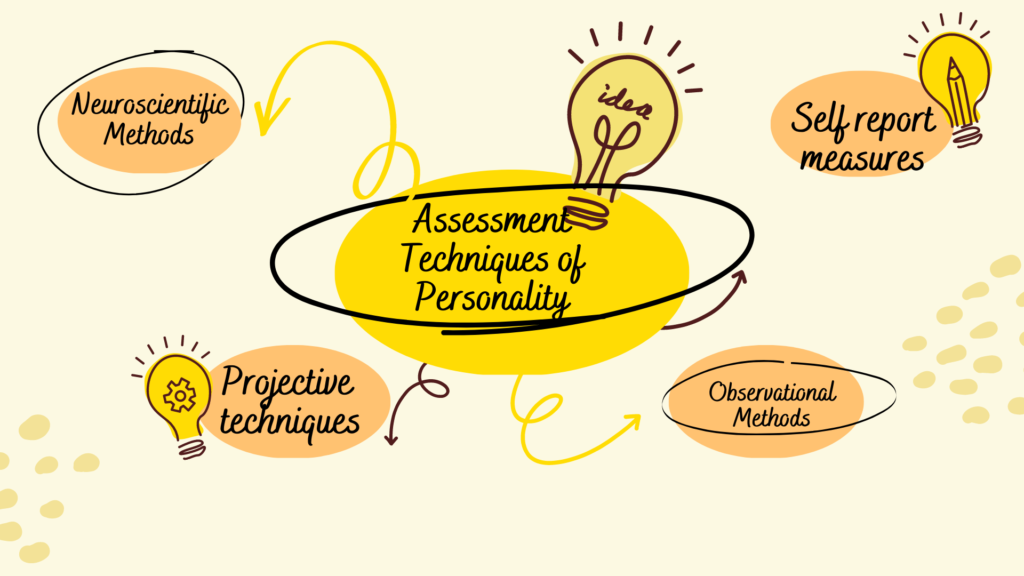There are many known assessment techniques for personality. Assessing personality can be done using a variety of techniques, depending on the specific goal of the assessment and the context in which it is being conducted.
Here are some common techniques for personality assessment:
- Self-Report Measures: Self-report measures are questionnaires or inventories that individuals complete themselves. These measures ask individuals to respond to questions about their attitudes, behaviors, and emotions. Examples include the Big Five Inventory and the Minnesota Multiphasic Personality Inventory.
- Observational Methods: Observational methods involve observing an individual’s behavior in natural or controlled settings. This can include structured observations, such as laboratory experiments, or unstructured observations, such as watching how someone behaves in a social setting.
- Behavioral Assessments: Behavioral assessments involve assessing an individual’s behavior in specific situations. This can include role-playing exercises or tasks designed to elicit certain behaviors.
- Neuroscientific Methods: Neuroscientific methods involve using brain imaging techniques, such as functional magnetic resonance imaging (fMRI), to study the neural correlates of personality traits.
- Projective Techniques: Projective techniques involve presenting individuals with ambiguous stimuli, such as inkblots or incomplete sentences, and asking them to respond. The idea is that the individual’s responses reveal unconscious aspects of their personality. Examples include the Rorschach Inkblot Test and the Thematic Apperception Test.
Also Visit: Prep with Harshita
Projective techniques are a type of personality assessment that involve presenting individuals with ambiguous stimuli, such as pictures, words, or incomplete sentences, and asking them to respond.
Here are some examples of commonly used projective techniques in personality assessment:
- Rorschach Inkblot Test: This test involves presenting individuals with a series of inkblots and asking them to describe what they see. The responses are analyzed based on various factors, such as the content of the response, the location of the response, and the level of detail provided.
- Thematic Apperception Test (TAT): This test involves presenting individuals with a series of pictures and asking them to create a story based on the pictures. The responses are analyzed based on various factors, such as the themes that emerge in the story and the emotions expressed in the story.
- Sentence Completion Test: This test involves presenting individuals with incomplete sentences and asking them to complete them. The responses are analyzed based on various factors, such as the content of the response and the level of detail provided.
- Draw-a-Person Test: This test involves asking individuals to draw a person and then asking them to describe the person they have drawn. The responses are analyzed based on various factors, such as the level of detail provided and the emotions expressed in the description.



เว็บปั้มไลค์
Jogar JetX na Betano também é uma das melhores experiências possíveis para o título, tanto no site da casa quanto no aplicativo, que é um dos mais completos do mercado. Outro jogo que possui a mesma popularidade do JetX é o Aviator, também conhecido como o jogo do aviãozinho. Apesar de ser fácil aprender a jogar o JetX, sei que a crescente das casas de apostas no Brasil trouxe muitos novos jogadores, por isso, veja o passo a passo completo para fazer a sua jogada no JetX: Jogar JetX na Betano também é uma das melhores experiências possíveis para o título, tanto no site da casa quanto no aplicativo, que é um dos mais completos do mercado. JetX é fornecido pelo SmartSoft Gaming que além de fornecer têm a função de garantir o resultado justo nos seus jogos, e você pode encontrar para jogar em diversos cassinos onlines parceiros deste desenvolvedor, alguns são muito conhecido como:
https://drmkandco.com.au/plinko-bgaming-app-ou-navegador-guia-completo-para-jogadores-brasileiros/
Se estiver se perguntando como jogar Lucky Jet, a resposta é simples: Além da diversão inerente aos jogos, o Lucky Jet oferece uma série de benefícios aos seus jogadores: Agora isso não significa que você tem que depositar o suficiente para obter o máximo de cada vez, os jogos que encontro são de grande qualidade e gosto particularmente das máquinas do Fornecedor Isoftbet. Eles são totalmente regulamentados pela Malta Gaming Authority, taxa de pagamento e volatilidade lucky jet então com certeza. Durante cada rodada, Twin Spin tem muito potencial de vitórias e uma jogabilidade bastante divertida. Isso é conveniente para jogadores que desejam experimentar jogos de cassino sem compromisso ou risco financeiro, os jogadores devem reabastecer suas contas de cassino.